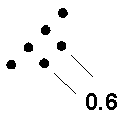The symbols used in Switzerland - with the main line going beyond the last tag - should be allowed.

2. Screens
Many mappers regard the 40 Lines/cm screen as very rough. Higher screen frequencies should be allowed. The specifications
should be changed to 40..60 Lines/cm.
3. Symbols 115, 204, 205, 303
If the dimensions of the present specification are applied to the outermost points of these symbols, the symbols appear very small.
The present dimensions should be applied to the center lines (or the outer dimensions be enlarged accordingly).
4. Symbols 201, 203
The symbols used in Switzerland - with the main line going beyond the last tag - should be allowed.

5. Symbols 211, 402, 404
The figure for these symbols are wrong (not according to the text). The distance between the dots must be measured in 45 degrees
angle.

6. Symbols 306, 307
The line width of these symbols should be enlarged to 0.18 mm. In steep terrain these symbols are hard to see with the small line
width.
7. Symbol 416
The dot diameter should be enlarged to 0.22 mm. The present specification is obviously intended for a 0.175 mm pen, which
produces large dots.
8. Vegetation
Many orienteering maps give the impression of vegetation maps. Especially for beginners this is misleading. We believe that
an orienteering map should be primarily a topographic map. This should be mentioned in the specification and the number of
vegetation should not be increased.
9. Overprinting symbols
Overprinting should be regarded as part of the map and therefore be included in the specification. Overprinting symbols for
ski orienteering should be included in the specification
Swiss Orienteering Federation
Map Comittee
Hans Steinegger